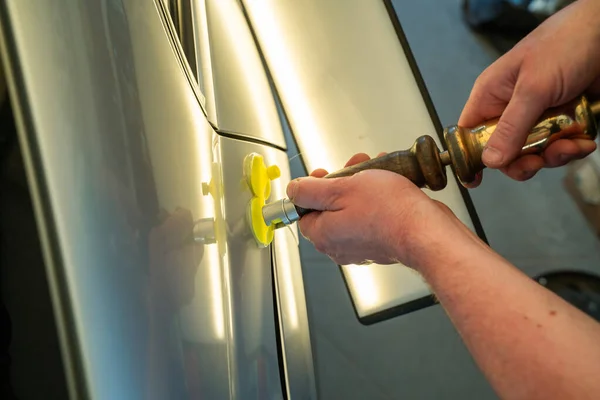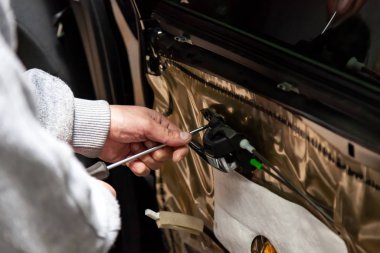Door Ding Repair: Simple Fixes That Save Your Car's Looks!
We've all experienced the frustration of returning to our parked vehicle only to discover an unattractive door ding or dent. These imperfections can result from a negligent driver, a runaway shopping cart, or even another car's door. Such damages can detract from both the aesthetic appeal and worth of your car. Thankfully, you don't always need to go to an auto body shop to address these minor flaws. With some straightforward methods and tools, you can bring back your car's sleek and flawless appearance.
This guide will cover simple do-it-yourself techniques for fixing door dings, advice on when to seek professional assistance and strategies for avoiding future dents.
Understanding Door Dings
Before exploring repair techniques, it's crucial to grasp the nature of door dings and the circumstances that lead to their occurrence.
What Are Door Dings?
Door dings refer to minor dents or indentations that often happen when a car door or another object lightly strikes your vehicle's exterior. Generally, these dings are not very deep and do not harm the paint, which makes them easier to handle compared to more severe dents or scratches.
How Do Door Dings Happen?
The majority of door dings happen in parking areas where cars are parked closely together. Common reasons include doors being opened carelessly, shopping carts wandering off, or items striking the sides of vehicles. Even slight collisions or contact with poles and walls can lead to these dents.
Simple Fixes for Door Dings
You don't necessarily need to visit a body shop to fix door dings. Often, you can tackle these repairs at home with basic tools or affordable repair kits. Below are some useful techniques for addressing door dings on your own.
Use a Hairdryer and Compressed Air
This is among the most well-liked and simplest do-it-yourself techniques for repairing minor dents.

How it works:
- Step 1: Use a hairdryer to warm up the dented spot. This will make the metal expand a bit.
- Step 2: Once you've heated it for roughly 30 seconds to a minute, quickly apply compressed air to the area. The rapid drop in temperature will lead to the metal contracting, which can help push the dent out.
This method is most effective for minor, superficial dents. It's fast, affordable, and doesn't need any specialized expertise.
Plunger Method
If your dent is bigger and more prominent, a regular household plunger can be quite effective.
How it works:
- Step 1: Moisten both the plunger and the dented surface to establish suction.
- Step 2: Position the plunger over the indentation and gently pull it outward.
- Step 3: If needed, continue this process until the dent is fully removed.
This technique is particularly successful for bigger, shallow indentations and operates in a manner akin to that of professional suction devices.
Boiling Water and Hand Pressure
Boiling water can soften plastic components, such as bumpers, making it easier to fix dents.
How it works:
- Step 1: Heat some water until it boils and then pour it over the dented section to make the plastic more pliable.
- Step 2: If possible, access the back of the plastic and gently push out the dent using your hands or a gentle tool.
- Step 3: Once the dent is removed, apply cold water to the area to restore the plastic's firmness.
This technique is straightforward yet works well on plastic surfaces, particularly when the indentation isn't very deep.
When to Call in a Professional
Although do-it-yourself techniques are effective for minor to moderate dents, certain damage might necessitate the skills of a professional. Door ding repair involves quickly removing small dents without damaging the vehicle’s original paint. Here are the situations in which you should consider getting assistance:
Paint Damage
If the door ding has caused any chips or scratches in the paint, it's advisable to seek help from a professional. Attempting to fix it yourself may not resolve the paint issues, which could expose your car to rust and additional harm.
Complex Dents
Fixing significant, deep dents or those found on intricate curves of your vehicle's exterior can be challenging to do by yourself. Experts utilize specialized equipment, such as paintless dent repair (PDR) kits, which effectively eliminate the blemish while preserving the factory finish.

Repeated Failed Attempts
If you've attempted several do-it-yourself approaches and haven't achieved the desired results, enlisting a professional may be wise. Repeatedly trying to repair a dent on your own can occasionally exacerbate the issue, leading to higher repair costs.
Tips for Preventing Future Door Dings
It's always wiser to prevent issues than to fix them later. Below are some suggestions for steering clear of door dings and maintaining your vehicle's appearance.
Park Away From High-Traffic Areas
Parking areas are notorious for door dings, particularly when cars are parked nearby. To minimize damage, choose spots that are farther from crowded entrances, cart return areas, or closely packed rows. It's advisable to select parking spaces that offer more space, even if they are a bit further away.
Use Car Door Guards
Purchasing car door protectors can safeguard your vehicle against unforeseen collisions. These protectors are simple to set up and can cushion the impact from other doors or items, helping to avoid dents.
Be Mindful When Opening Doors
Always be cautious when opening your doors, particularly in confined areas. Instruct your passengers to follow suit, and try to park with ample space between your vehicle and others whenever you can.
Cover Your Car in High-Risk Areas
If you frequently leave your vehicle in places prone to damage, like near construction zones or busy parking lots, it might be wise to use a car cover for additional protection.
110 E 43rd St, Suite 120
Garden City, Idaho 83714, USA
Phone: (208)-251-5338

